facts about the egg industry you may not know
Join Animal Place on March 13th for the premiere of our newly-extended documentary Turlock, profiling the largest rescue of farmed animals in California history. Screening is at the Guild Theater in Sacramento. Tickets are only $10, get them here.
1. parent birds are horribly abused
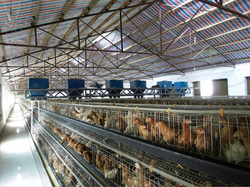
A commercial breeding operation
The parents of most hens used by the egg industry are housed in sheds with one rooster for every 9-11 hens. As many as 10,000 hens and roosters are housed in a shed with about 1.88-2 square feet per bird (Source). Prior to arriving at the breeder facility, the birds may be beak-trimmed, de-spurred, dubbed (comb cut off on roosters), and sometimes de-toed to prevent aggression. These procedures are generally performed without anesthesia or analgesics.
The birds are fed once a day, with eggs being collected three times a day for transport to a hatchery for incubation. Each year, the end of their first laying cycle, most breeder hens are sent to slaughter and replaced by a new flock of pullets (young hens). Roosters may be retained for longer than 18-months.
The birds are fed once a day, with eggs being collected three times a day for transport to a hatchery for incubation. Each year, the end of their first laying cycle, most breeder hens are sent to slaughter and replaced by a new flock of pullets (young hens). Roosters may be retained for longer than 18-months.
2. male chicks are ground up alive
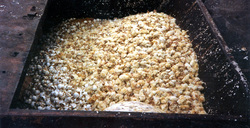
Male chicks tossed in dumpster to die
Fertilized eggs from commercial layer hen breeders are transported to hatcheries. Incubators provide uniform heat to the eggs so they will hatch at the same time. Some facilities have 300,000 eggs. After a 21-day incubation period, chicks hatch. In the wild, they would receive assistance from their mother during the hatching process. The hen vocalizes to her offspring throughout incubation. Chicks in incubators at hatcheries hear silence.
In the egg-industry, male chicks are killed the day they are sexed. It is not profitable to raise males from commercial egg breeders to maturity. It is legal to macerate (grind alive), gas or suffocate male chicks. In the United States, up to 200 million male chicks are killed annually. If a farm does not incubate eggs themselves, it is almost a guarantee they are purchasing chicks from hatcheries that kill male chicks. This includes caged, cage-free, free-range and even many pasture-based operations.
In the egg-industry, male chicks are killed the day they are sexed. It is not profitable to raise males from commercial egg breeders to maturity. It is legal to macerate (grind alive), gas or suffocate male chicks. In the United States, up to 200 million male chicks are killed annually. If a farm does not incubate eggs themselves, it is almost a guarantee they are purchasing chicks from hatcheries that kill male chicks. This includes caged, cage-free, free-range and even many pasture-based operations.
3. female chicks are mutilated
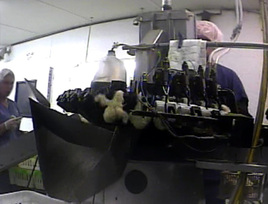
If chicks are destined to egg facilities with high stocking densities, a portion of their nerve- and blood-rich beak is cut off. Birds housed in unnatural social settings, like those found on intensive egg farms, exhibit abnormal behaviors, including misplaced aggression and cannibalism. This is only a result of how they are housed, not the birds' natural behaviors.
De-beaking can be performed with a laser, cauterizing knife, scissors, or via electrical current. Even the conservative American Veterinary Medical Association (AVMA) indicates that this procedure, performed without analgesics or anesthesia, is painful and has welfare concerns, including prolonged suffering (source).
Hens on cage and cage-free operations are generally always beak-trimmed. Free-range farms that intensively confine birds debeak as well. Even some small pasture-based farms debeak.
De-beaking can be performed with a laser, cauterizing knife, scissors, or via electrical current. Even the conservative American Veterinary Medical Association (AVMA) indicates that this procedure, performed without analgesics or anesthesia, is painful and has welfare concerns, including prolonged suffering (source).
Hens on cage and cage-free operations are generally always beak-trimmed. Free-range farms that intensively confine birds debeak as well. Even some small pasture-based farms debeak.
4. 95% of hens are crammed into cages so small they cannot spread their wings
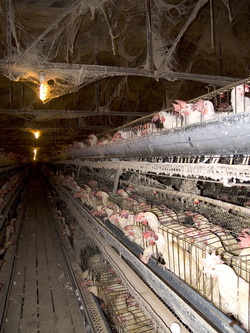
Standard housing for caged hens
95% of the nearly 400 million "egg-laying" hens in the United States are housed in battery cages. These are wire-metal cages, sometimes tiered as high as seven, in which 5-8 birds are housed for the duration of the laying period. Birds cannot stretch their wings and can only barely turn around. Each hen has less space than a standard piece of paper.
Between 60,000-100,000 hens will be housed in one shed and most farms have multiple buildings on site.
Cages increase abnormal or stereotypic behaviors, like vacuum or false dust-bathing and pecking/cannibalism.
To reduce the spread of disease and increase egg production, hens are fed an antibiotic-laced feed.
Even in cage-free operations, birds are still de-beaked and have little space to roam. Cage-free operations house 10,000-50,000 hens in one building. Most do not have windows.
There is no legal definition of cage-free or free-range. Most free-range operations still de-beak the hens. Less than 1% of hens are housed on free-range or pasture-based operations.
Between 60,000-100,000 hens will be housed in one shed and most farms have multiple buildings on site.
Cages increase abnormal or stereotypic behaviors, like vacuum or false dust-bathing and pecking/cannibalism.
To reduce the spread of disease and increase egg production, hens are fed an antibiotic-laced feed.
Even in cage-free operations, birds are still de-beaked and have little space to roam. Cage-free operations house 10,000-50,000 hens in one building. Most do not have windows.
There is no legal definition of cage-free or free-range. Most free-range operations still de-beak the hens. Less than 1% of hens are housed on free-range or pasture-based operations.
5. hens are prisoners in their own body
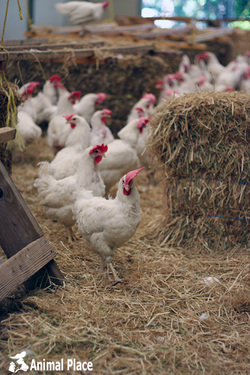
Hens rescued from a battery cage farm
The breeds most commonly used in egg production have been artificially selected to produce 3-5 times more eggs than normal. These breeds lay 250-300 eggs a year, while wild or feral chickens produce 20-50 eggs a year. Even other traditional egg producing breeds produce 120-160 eggs per year, far fewer than hi-laying breeds of hens.
On most farms, where birds are housed indoors without access to normal light, chickens are conned into thinking it’s always spring. Indoor lights are on for 12-16 hours a day during peak lay. In a cruel twist of nature, molting is induced in these birds through feed withdrawal. Approximately 75% of hens are forced molted. In a natural environment, hens undergo a molting process in which they shed all their feathers and prepare their bodies and reproductive system for the next laying cycle. On farms, though, hens are starved 2-11 days.
The result of unnatural egg production includes osteoporosis and bone breaks. Up to 30% of hens in the egg-laying industry suffer from osteoporosis. Reproductive problems, like ovarian cancer, are prevalent in hens from high egg production breeds. Because of this, when given an opportunity to live on a sanctuary, birds rarely live past the age of 7.
On most farms, where birds are housed indoors without access to normal light, chickens are conned into thinking it’s always spring. Indoor lights are on for 12-16 hours a day during peak lay. In a cruel twist of nature, molting is induced in these birds through feed withdrawal. Approximately 75% of hens are forced molted. In a natural environment, hens undergo a molting process in which they shed all their feathers and prepare their bodies and reproductive system for the next laying cycle. On farms, though, hens are starved 2-11 days.
The result of unnatural egg production includes osteoporosis and bone breaks. Up to 30% of hens in the egg-laying industry suffer from osteoporosis. Reproductive problems, like ovarian cancer, are prevalent in hens from high egg production breeds. Because of this, when given an opportunity to live on a sanctuary, birds rarely live past the age of 7.
6. hens can be slaughtered while fully conscious
There are two federal laws that apply to farmed animals - the 28 Hour Transport law and the Federal Methods of Humane Slaughter Act. But the vast majority of animals slaughtered are NOT protected by either law. Federal courts have determined that chickens and turkeys (making up >90% of animals slaughtered) are not livestock and therefore not protected. This means they can be transported for any period of time without food and water, and they do not have to be stunned insensible to pain prior to slaughter.
Chickens are fully conscious when their throats are cut. After a rough unloading, birds are shackled upside down by their legs. Birds are generally run through an electric water bath, which can induce death but at poorly operated slaughterhouses (read most), birds are only immobilized and still fully conscious when their throats are cut.
Chickens raised for their flesh are much larger than egg-laying breeds. There is not a large market for the flesh of hens from the egg-laying industry. Most of the 200+ million hens are sold for soup stock, dog/cat food, or used as composting.
Chickens are fully conscious when their throats are cut. After a rough unloading, birds are shackled upside down by their legs. Birds are generally run through an electric water bath, which can induce death but at poorly operated slaughterhouses (read most), birds are only immobilized and still fully conscious when their throats are cut.
Chickens raised for their flesh are much larger than egg-laying breeds. There is not a large market for the flesh of hens from the egg-laying industry. Most of the 200+ million hens are sold for soup stock, dog/cat food, or used as composting.
7. mail order hatcheries and feedstores are no better
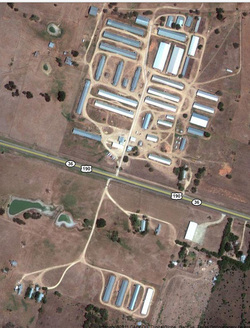
Breeding and hatching facility
There is a growing interest in rearing chickens in urban settings. While rescued chickens can be wonderful companions, there are issues with the backyard chicken movement.
To the left is an aerial image of the largest hatchery supplying chicks to the backyard chicken movement (and small scale farmers). This facility confines parent birds in windowless sheds and hatches chicks in artificial incubators. Like on all smaller hatcheries, parent birds are slaughtered at the young age of 18-months-old.
It is legal to ship day-old chicks through the postal service. Chicks are temperature sensitive and this method of transport endangers their health. Chicks can be as young as newly hatched and as old as 72-hours. The yolk provides nutrition for three days post-hatch. This combining of different aged birds is what leads to some chicks dying en route. Day-old chicks are classified as "perishable goods" by the postal service.
According to the hatcheries themselves, rooster chicks who are not automatically gassed to death or sold in straight runs are used as "packing peanuts" to keep hen chicks warm. Roosters are not legal in most urban settings, leading to an increase in unwanted birds. Shelters are often unable to place roosters and most are killed. Other roosters are sent to feed stores, where they are often sold for slaughter. And some are abandoned where they face starvation or predation.
While chickens can live 7-10 years, a hen's egg production begins to decline around age two. She will continue to lay for several years, but many people purchase chickens expecting a lifelong supply of eggs. When that does not occur, hens are abandoned. This is the problem inherent to viewing chickens as egg machines and not as unique individuals.
To the left is an aerial image of the largest hatchery supplying chicks to the backyard chicken movement (and small scale farmers). This facility confines parent birds in windowless sheds and hatches chicks in artificial incubators. Like on all smaller hatcheries, parent birds are slaughtered at the young age of 18-months-old.
It is legal to ship day-old chicks through the postal service. Chicks are temperature sensitive and this method of transport endangers their health. Chicks can be as young as newly hatched and as old as 72-hours. The yolk provides nutrition for three days post-hatch. This combining of different aged birds is what leads to some chicks dying en route. Day-old chicks are classified as "perishable goods" by the postal service.
According to the hatcheries themselves, rooster chicks who are not automatically gassed to death or sold in straight runs are used as "packing peanuts" to keep hen chicks warm. Roosters are not legal in most urban settings, leading to an increase in unwanted birds. Shelters are often unable to place roosters and most are killed. Other roosters are sent to feed stores, where they are often sold for slaughter. And some are abandoned where they face starvation or predation.
While chickens can live 7-10 years, a hen's egg production begins to decline around age two. She will continue to lay for several years, but many people purchase chickens expecting a lifelong supply of eggs. When that does not occur, hens are abandoned. This is the problem inherent to viewing chickens as egg machines and not as unique individuals.



